I examine notions of memory, identity, place and belonging. Since change is inevitable outside and within, my work is fluid and defiantly so – regardless of what the current art trends may be or what the art market says. I regard the studio as a place of experimentation, response and creation and claim that space for complete freedom of thought.
Milwaukee-based interdisciplinary artist, Nirmal Raja, creates and curates work in response to the personal and the ever-shifting political landscape.
Featured image above: Downtown. Sari 18, (From Reaching through 5 ½ yards | 8497 miles), Lois Bielefeld and Nirmal Raja, 2017
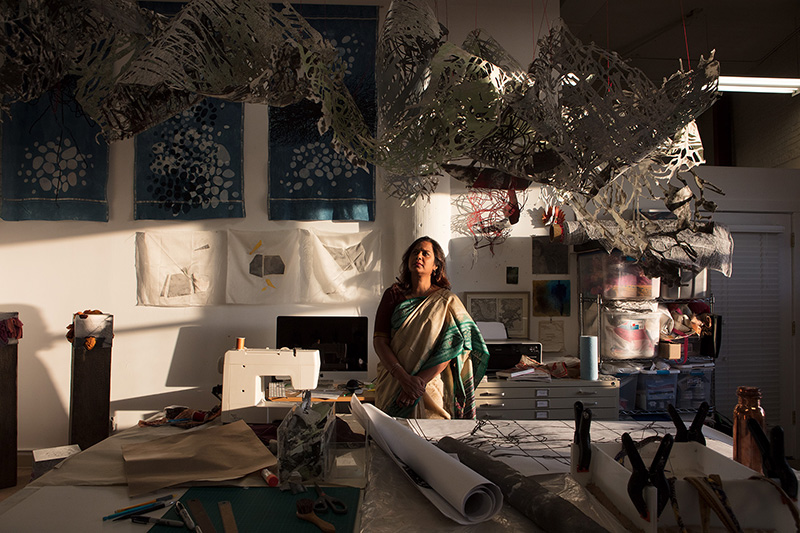
Nirmal’s Studio- Sari 45. (From Reaching through 5 ½ yards | 8497 miles), Lois Bielefeld and Nirmal Raja, 2018
Take us to the beginning of your story. How did your tryst with art begin?
I’ve always been attracted to “making” as a child; even if I didn’t understand until later that this would become what I now call “art”. I appreciated beauty in all its forms, and there was plenty that surrounded me visually. I grew up making rangoli, crocheting and embroidering with my grandmother, decorating food, and sewing garments. These acts of creation still remain part of my art practice. I studied English literature in college, and after coming to the US, I studied art between raising two children and many moves. I taught at the University of Wisconsin Milwaukee’s art department for three years, and then left in order to spend more time in the studio.
Started exhibiting locally in small group shows and eventually working my way outwards – reaching across the nation and forming connections internationally through friends and mentors. My professional path has been interrupted and has evolved many times due to life changes and will continue to do so… I have learned to embrace this and yet not waver in an art practice. I can’t think of doing anything else.
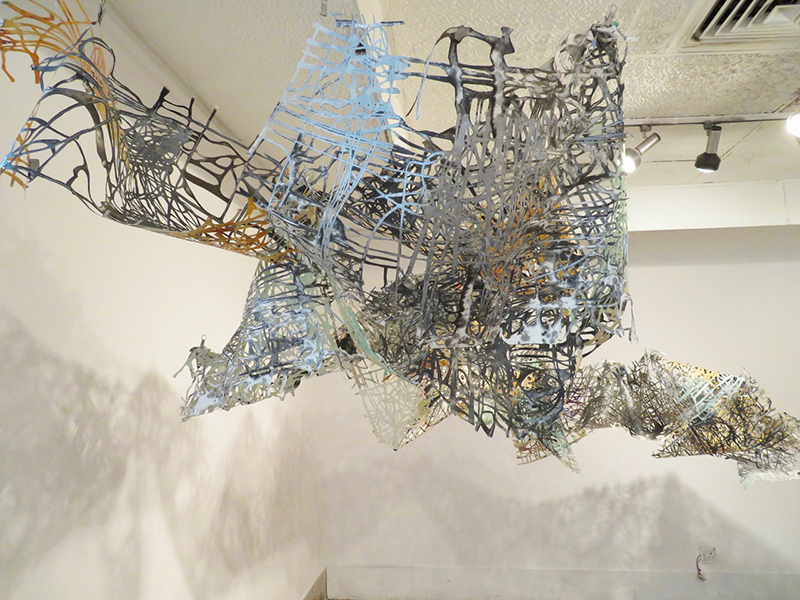
Blurred boundaries. Nirmal Raja.
What is the primary role of an artist?
Artists tend to be observers of society and become our social conscience if you will, through the work. We hold a mirror to our audience – asking them to pause, dig deeper, question assumptions and blind beliefs, while revealing an essence or truth. Being an artist is indeed “work”, even if we mostly enjoy what we do. It is not something we do as an escape from reality, but it is about staring reality in the face. It takes courage, honing of skills, and incredible focus and labor. We are the cultural producers, and without us, “meaning” is harder to find.
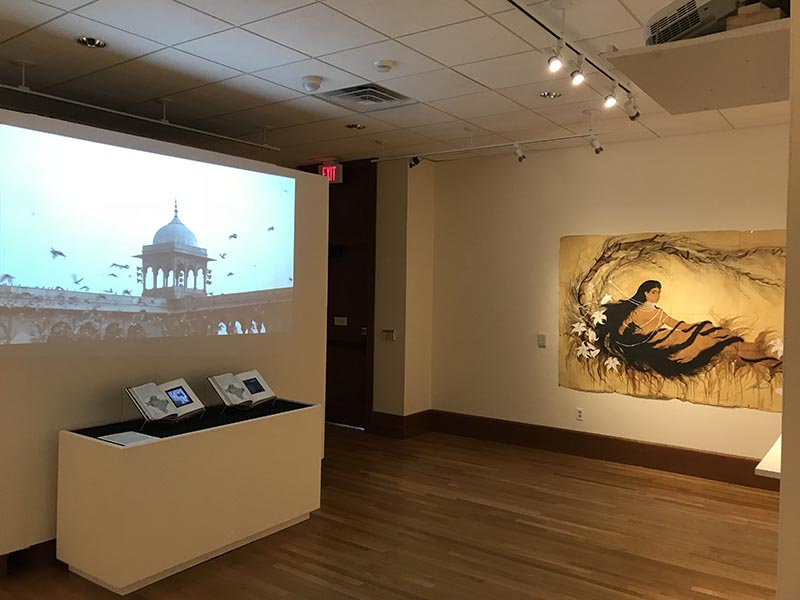
Reclaimed Baggage (curatorial project), Nirmal Raja. Northern Illinois University Art Museum, 2018
What were your biggest learnings and hiccups along the way?
I found it difficult to represent abstract notions of time and represent the relentless change that I experienced everyday as a parent and a global citizen. Two-dimensional art seemed insufficient and limited for expressing a sense of fluidity that was very important for me to express. Graduate school gave me freedom to think about art beyond a particular discipline. My work became more conceptual, and anything and everything became my material as long as it served the idea. It doesn’t matter what the material is – if the idea calls for it, I use it. The information technology that is at our fingertips right now makes it possible to teach ourselves many things. I also collaborate with experts and fellow artists when my own knowledge falls short.
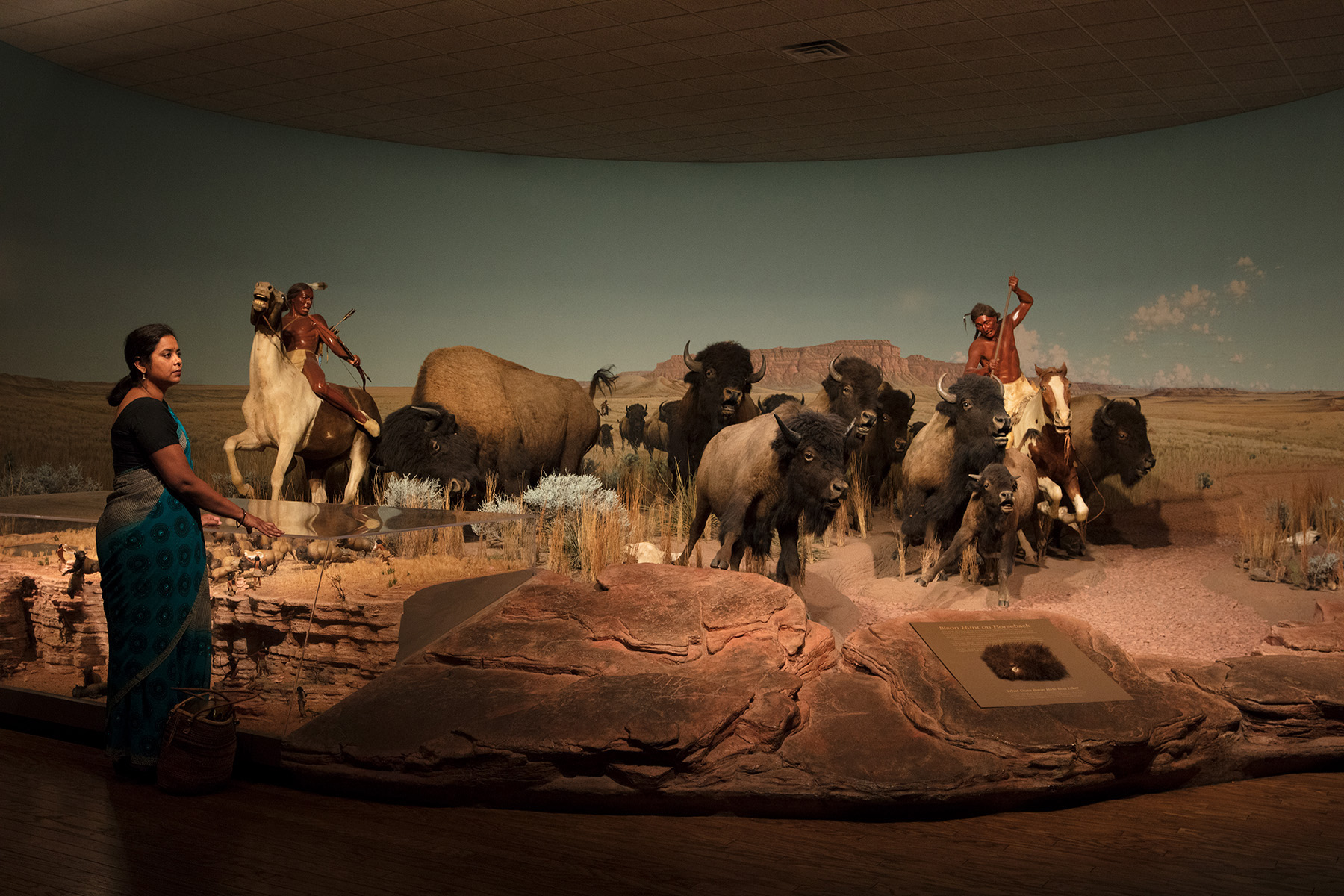
Milwaukee Public Museum, Sari 49. (From Reaching through 5 ½ yards | 8497 miles), Lois Bielefeld and Nirmal Raja, 2018
How do you describe yourself in the context of challenging people’s perspectives via your work and art?
I had a huge creative block three years ago after the 2016 American elections. The country felt different after that moment and for the first time I began to question my role as an artist and a South Asian American.
Previously, my work was more an exploration of the self and its place in the larger universe. But now that seemed like an indulgence and didn’t seem to be relevant anymore. I reached out to other artists and read and listened a lot. This helped me find my voice again and my work has evolved since then. In response to increasing racial polarity in the United States, Lois Bielefeld and I launched two collaborative projects exploring identity, place, and belonging. While one project examines the role of garment and our visual understanding of race, the other questions the veracity of recorded history and our attempts to contend with it.

Wrapping Air In Cloth And Other Seemingly Impossible Acts (solo exhibition), Nirmal Raja. The Alice Wilds, 2019, Picture by Tyler Jones
What inspires you? Take us through your process and continuous frameworks of reference.
As someone who grew up in several places in India, and now lives in the United States, my vantage point will always be somewhere in-between. My work straddles the personal and the political and is a response to lived experiences that are distilled and strengthened by research in the studio and through reading. I examine notions of memory, identity, place and belonging. Since change is inevitable outside and within, my work is fluid and defiantly so – regardless of what the current art trends may be or what the art market says. I regard the studio as a place of experimentation, response and creation and claim that space for complete freedom of thought.
Having a poetic sensibility towards life helps me be creative. Most of my works come from personal experience that I then mould into a collective experience through “making”.
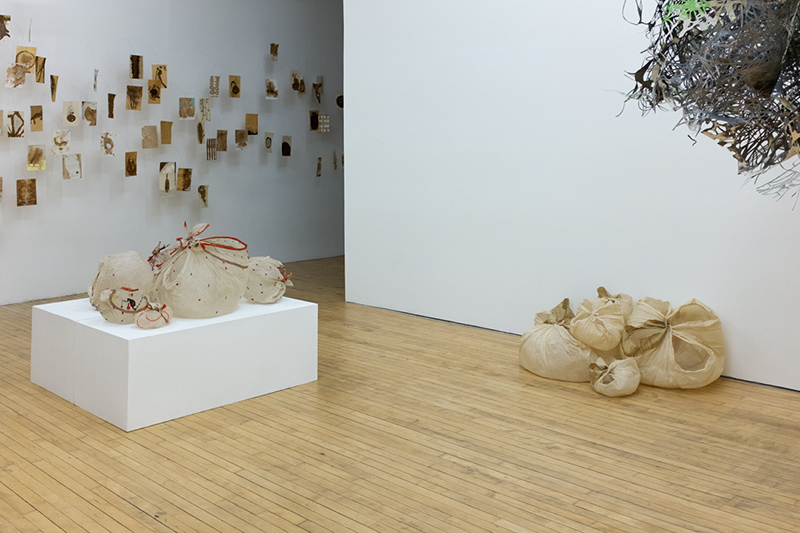
Solo exhibition. Nirmal Raja. Wrapping Air In Cloth and other seemingly impossible acts. Picture by Tyler Jones.
I tend to have many different projects or what I call “trains of thought” going on at the same time. So, if I get stuck with one, I move on to a different one, and this keeps me moving and exercising my creative muscle. I like to have focused deadlines. If I do not have a firm deadline or exhibition that I am part of, I create my own parameters. Mostly this starts with brain mapping and writing out a proposal for myself that explores a certain idea that interests me. I start playing with materials that I’ve accumulated in the studio. Concurrently, I do some reading on subjects that are tied to my idea.
I make plenty of mistakes, abandon work, and choose a direction that most excites me. The process needs to be exciting enough for me to work on over an extended period of time and rich enough to not feel like the work is repetitive or simplistic. One such major project was Vergence- An Orientalist Dystopia. (Site Specific Installation at the Villa Terrace Decorative Arts Museum in Milwaukee.) In this era of “post-truth” we are now given license to choose what we believe and disbelieve. Truth is now relative, and we are compelled to exist in multifaceted alternate realities. If this is the case, can we examine the archive with the same dystopic lens?
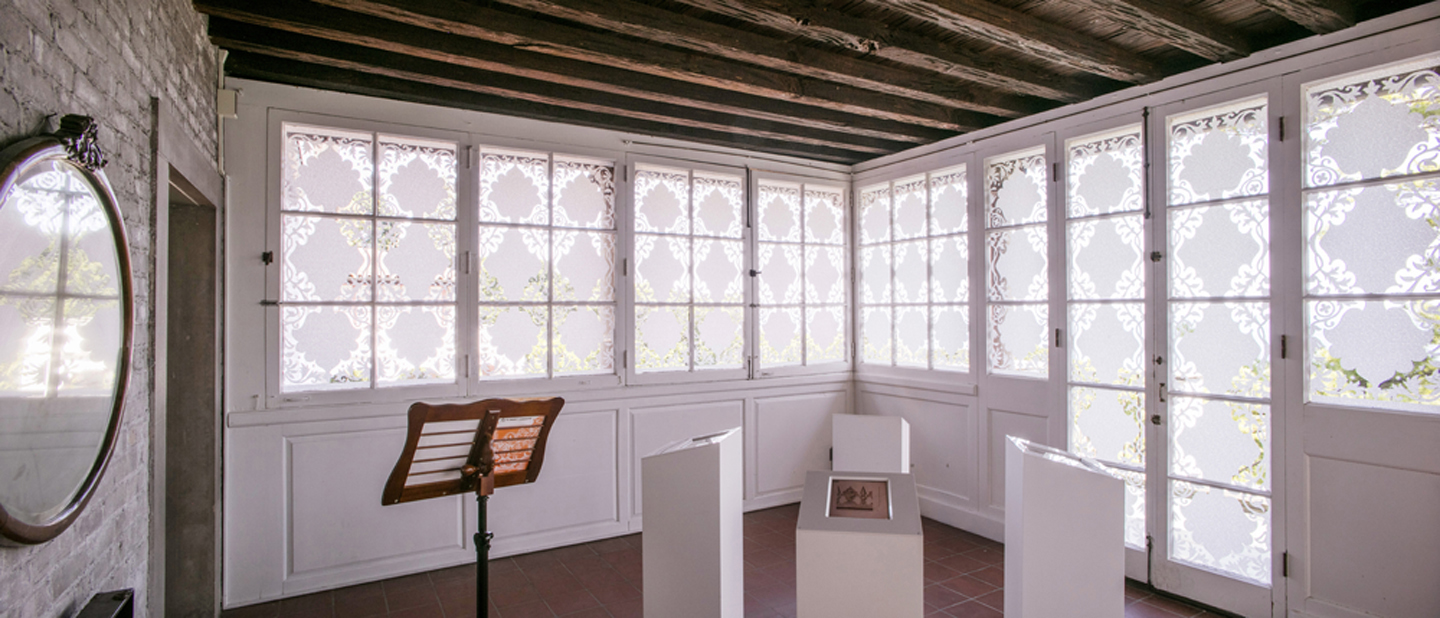
Site specific installation. Vergence – An Orientalist Dystopia. Nirmal Raja. Villa Terrace Decorative Arts Museum, Picture by Kevin Miyazaki
In this installation I bring together a selection of materials from the University of Wisconsin Milwaukee’s Special Collections and The American Geographical Society libraries and ephemera from my own personal collection, in an interactive and exploratory installation. I investigate how early perceptions of South Asia were formed and urge the viewers to form their own connections to the present. Most often, the West has seen Asia as either exotic and beautiful or dangerous and perverse. These perceptions continue to inform present day understanding of this region and people. I give the audience an opportunity to approach these materials with fresh eyes, reframed by the screen that surrounds the sleeping porch.
Using this structure of the “jaali” as a trope, I surround the viewer with a deceptively decorative screen inscribed with a listing of ongoing hate crimes against South Asian Americans sourced from the South Asian Americans Leading Together (SAALT) website. I ask the viewers to exercise “vergence”- an ophthalmic term that refers to the focus and alignment of eye movements. The viewers have the choice to focus on this list or look through the screen towards the blue lake and ignore the violence that is happening around them. By giving the audience agency to make their own connections and come to their own conclusions, I hope to bring attention to how our perceptions of the “other” have been mediated historically and how we make choices that unconsciously or consciously reflect bias and apathy.
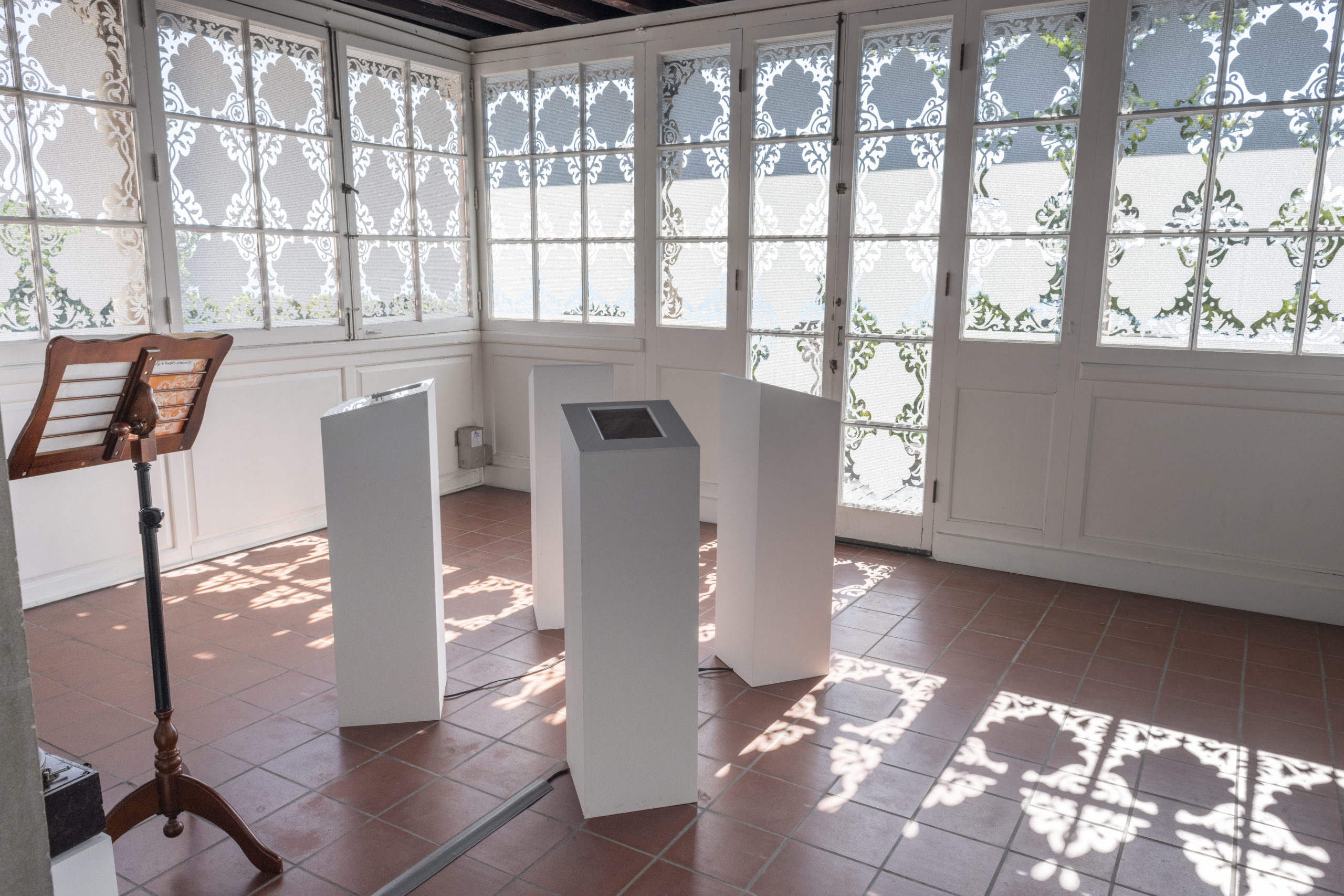
Site specific installation. Vergence – An Orientalist Dystopia. Nirmal Raja. Villa Terrace Decorative Arts Museum, Picture by Robb Quinn.
Having a “daily studio practice” or “studio warm ups” helps me start the day. These quick ‘one a day’ works are playful, freeing, and profound all at the same time. After sticking to certain material and size parameters, I end each series of studio warm ups at a 101 pieces. The large number pushes me to find variations within limitations and provides me with an instant gratification that is hard to get in my larger research based projects.
Learning a new technique and trying new materials also inspire me.
I love going to artist’s lectures more than opening receptions. It gives me an insight into how other artists think and strategize. I find this really inspiring and it keeps me current.
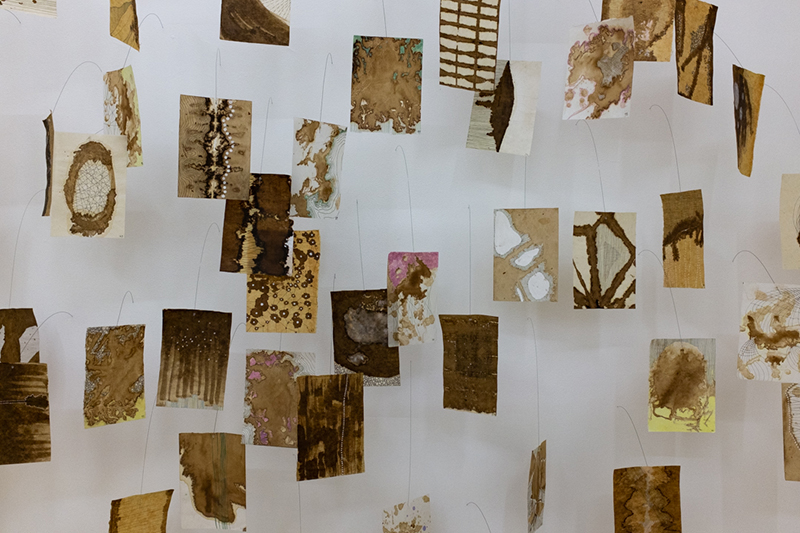
Flights Of Thought detail. Nirmal Raja. (second series of 101 daily studio practice)
How and when did the artist become a curator? Tell us about the evolution of your practice over the years. Tell us about your commitment to your current medium.
My curatorial practice emerges from a need to provide visibility to under-represented issues and artists and also to facilitate a global understanding. I feel like we are cocooned in our “American-ness” or “Indian-ness” and rarely step out of our comfort zone to connect with people different from us. Our politics reflects this in so many ways… these self imposed blinders do us a disservice. We have become homogenous in our visions and aesthetics. Through my curatorial projects, I like to cross-pollinate, so we can see what others see and perhaps begin to understand them. As a response to fear mongering that I see in political rhetoric, I feel an increasing responsibility towards furthering communication and understanding between cultures. It is this responsibility that I hope to fulfil through my curatorial practice while providing a platform for artists who explore notions of disenfranchisement, marginality, migration, globalization and intersectional identity.
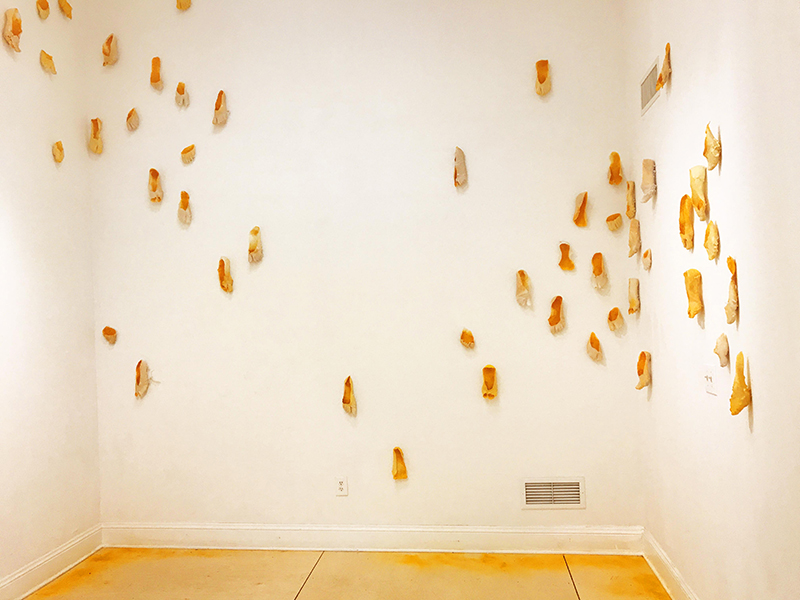
Protective Footwear, Nirmal Raja. Walker’s Point Center For The Arts, 2017
How do you balance the contradicting elements of art and curation?
I see my curatorial practice as an extension of my studio work. For me, the urge to curate comes out of a realization that my work/voice is not enough. I want to understand, showcase, and highlight multiple voices that focus on subjects that I am interested in exploring. It is more an act of finding kinship and amplifying work that I think is important to see and learn from.
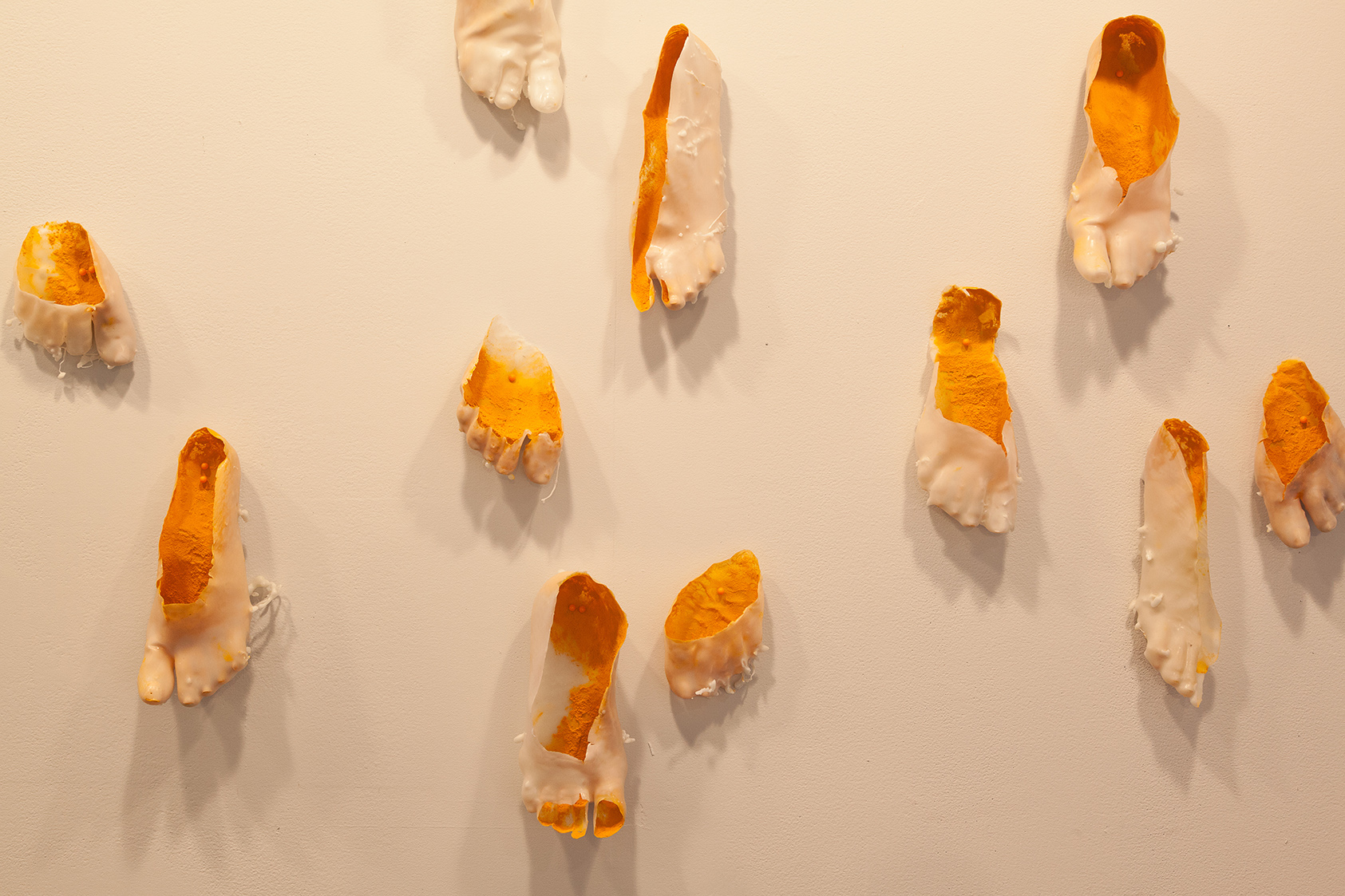
Protective Footwear detail, Nirmal Raja, Walker’s Point Center For The Arts, 2017
What are you looking for when you look at other artists’ work? Who are your maestros?
I am incredibly inspired by the rich array of art that is out there in the world. It is such a cornucopia of textured visual dialogues. I draw from artists who fit into post-colonial art frameworks, contemporary Indian art and contemporary Western art. Some of my favorite artists are Ann Hamilton for her poetic sensibility and visceral translation of experience, William Kentridge for providing me with a vision of addressing large issues in an aesthetic way, Wolfgang Laib for his paring down to the essential and the spiritual, Rina Banerjee and Bharti Kher for their use of materials and articulation of global concepts.
Kimsooja was my recent inspiration. Looking at her work provided me with tools and the courage to do the recent performance based project titled Reaching through 5 ½ yards | Reaching Across 8497 miles made in collaboration with Lois Bielefeld. It was a series of 70 performance based photographs in response to increasing racial polarity in the United States and explores identity, place, and belonging. On my reading list next is a book titled Ninth Street Women, highlighting the work of women artists like Helen Frankenthaler, Joan Mitchell, Lee Krasner, Elaine de kooning and Grace Hartigan who paved the way for women artists to claim space in the male dominated Western abstract expressionist world.
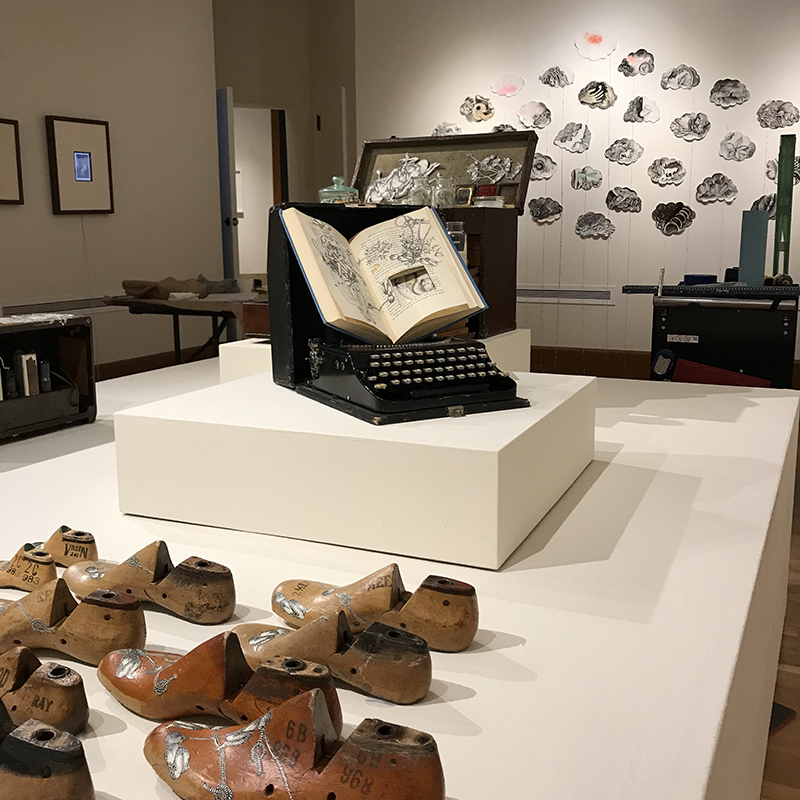
Reclaimed Baggage (curatorial project), Nirmal Raja. Northern Illinois University Art Museum, 2018
What are you working on now? What’s coming next season?
In the studio, I am dwelling on our relationship with objects. The intersection of memory, nostalgia and the sentiment we pour into what we hold on to and what we make. How does the formless nature of time, memory and transience take shape and come into being as we produce more objects through artistic production? I am also beginning a series of large abstract paintings on silk organza.
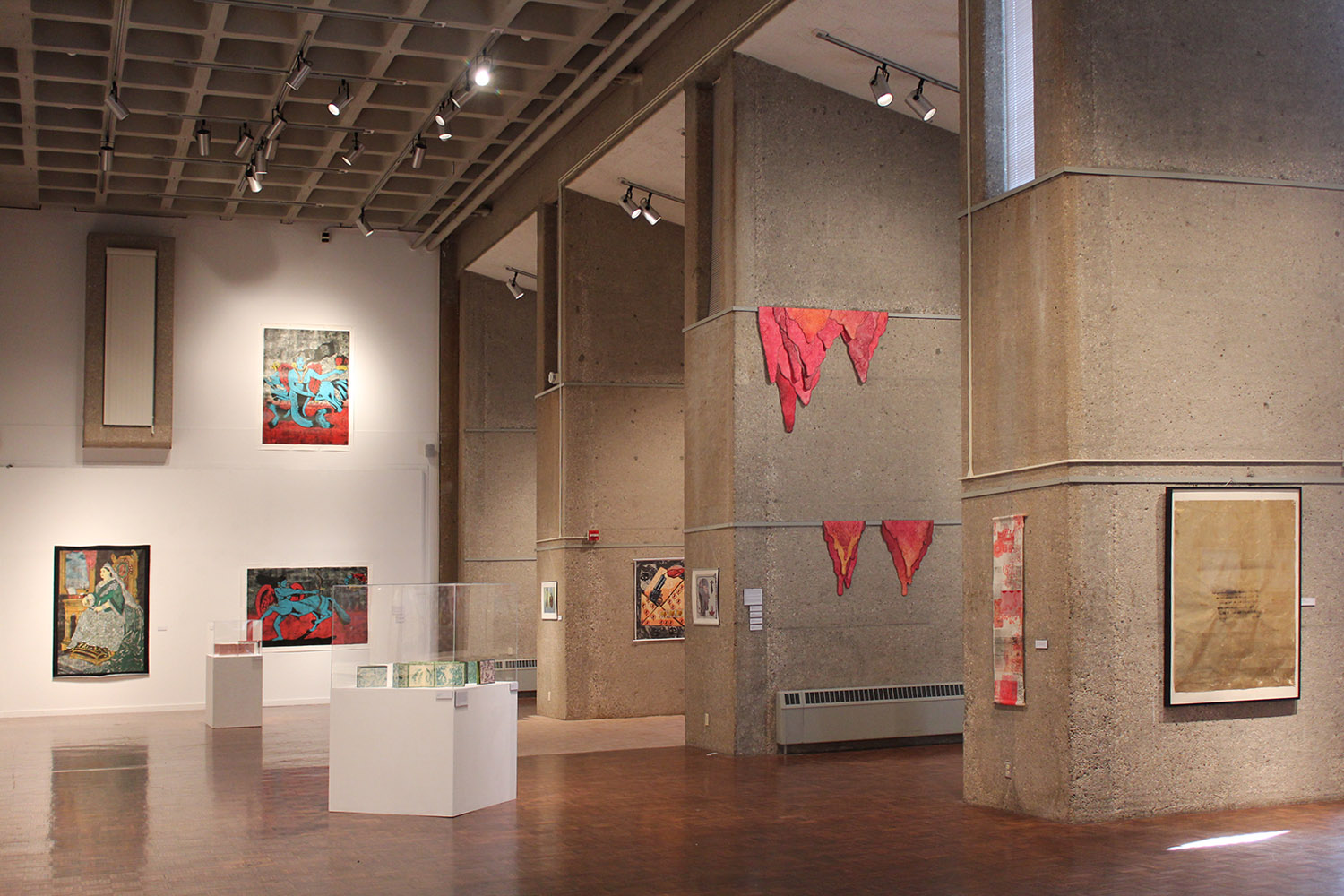
India Inked! Nirmal Raja (curatorial project), Union Gallery, University Of Wisconsin, Milwaukee, 2017
In the curatorial realm, I am organizing an exhibition at the Milwaukee Institute of Art and Design (my alma mater) for October 2021. It is in response to the increase in hyper nationalism and isolationist policies like walls, travel bans and tariffs in addition to the refugee crisis and rising xenophobia. I want to showcase how artists subvert these barriers, connect with others in a different country and produce meaningful work. It is important for students and viewers to be exposed to possibilities that lie beyond our borders and how connecting with others different from us might produce a richness of understanding and empathy.
This exhibition has strong aspects of collaboration, social engagement and “artivism” and provides tools to break away from isolationist thinking. It is a showcase of networking strategies, exchanges of ideas, participations and engagements with varied people from across the world and human connection. It addresses what currently is weighing down on our planet and the global community – issues of refugees at the borders, war, destruction and loss of life and the ever-present cloud of climate change. “Towards a Global Village” reveals various strategies artists have adopted towards a more connected and caring world.
Before you go – you might like to browse our Artist Interviews. Interviews of artists and outliers on how to be an artist. Contemporary artists on the source of their creative inspiration.








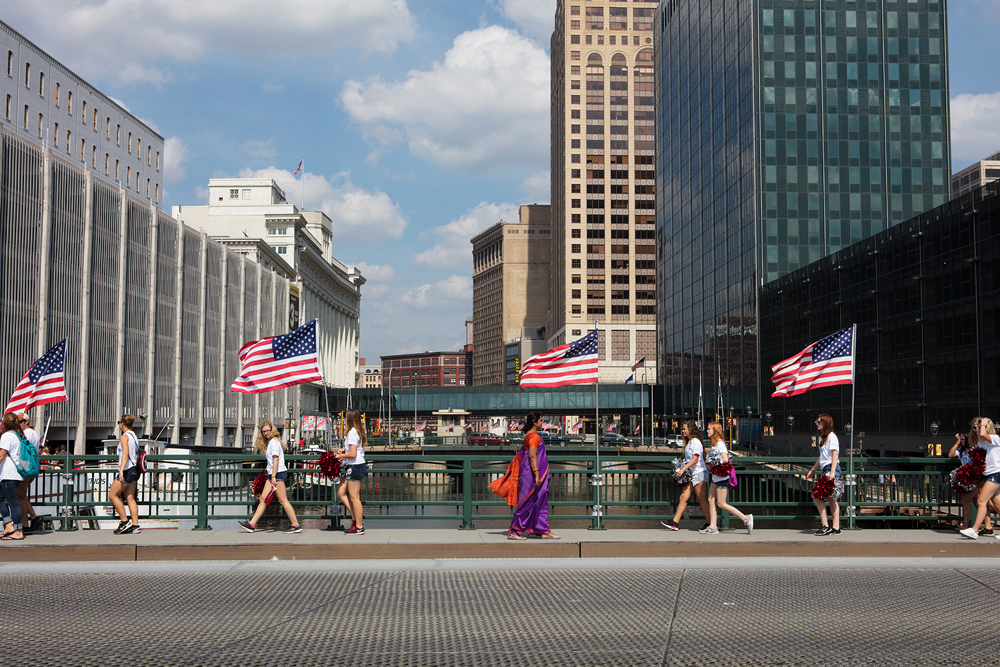



Add Comment